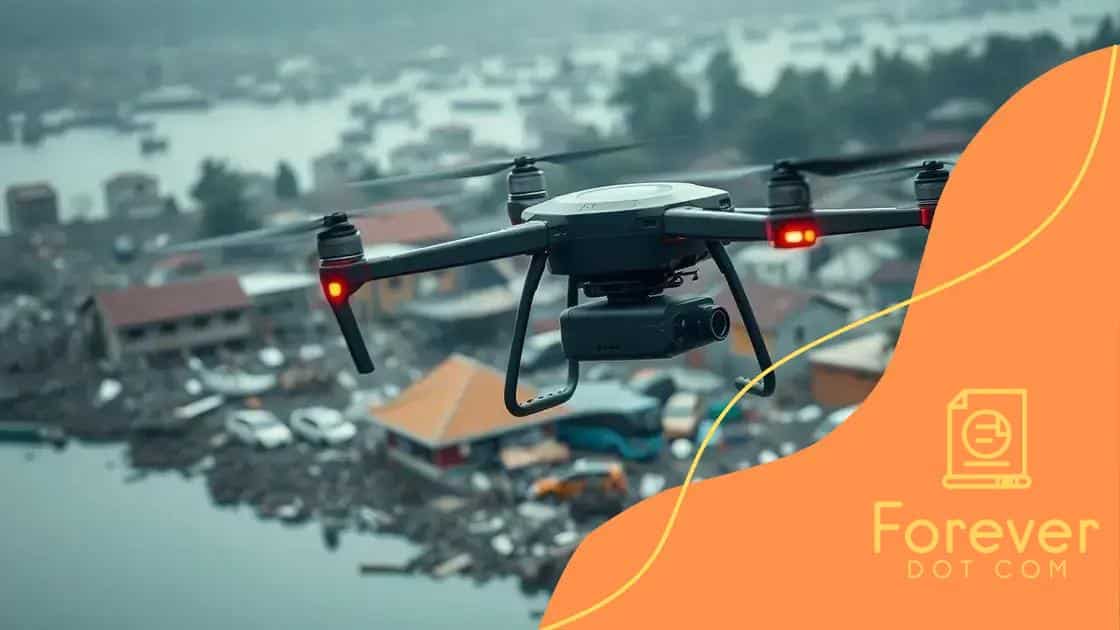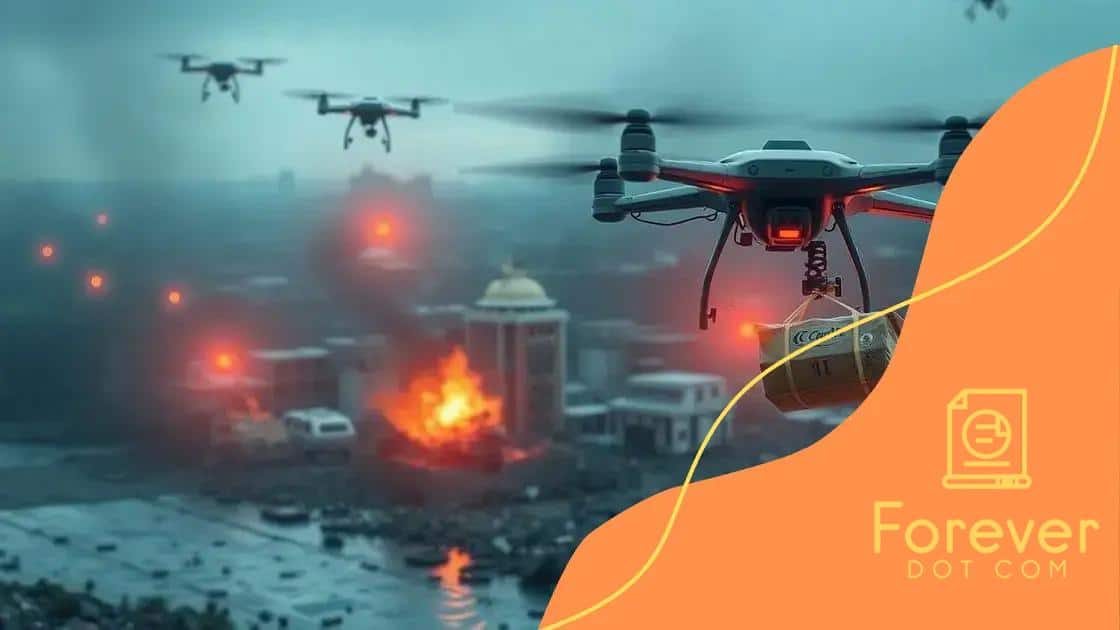How autonomous drones are improving disaster relief efforts

Autonomous drones are revolutionizing disaster relief by rapidly locating victims, assessing damage, and delivering supplies, enhancing the overall efficiency of emergency response efforts.
How autonomous drones are improving disaster relief efforts has become a vital topic in recent years. Imagine facing a natural disaster where every second counts—drones are stepping up in remarkable ways.
Understanding autonomous drones
Understanding autonomous drones is essential as we explore their role in disaster relief. These high-tech devices can operate independently, performing tasks with minimal human intervention. Their ability to navigate challenging environments makes them invaluable in emergencies.
Key Features of Autonomous Drones
Autonomous drones come with several important features that enhance their effectiveness:
- Advanced navigation systems that utilize GPS and sensors
- Automated flight paths that are programmed for specific missions
- Real-time data collection capabilities to assess situations
- Robust communication tools for coordination with relief teams
Furthermore, autonomous drones can fly in conditions that may be dangerous for humans, such as during a hurricane or after an earthquake. This allows them to gather crucial information and deliver supplies right where they are needed most.
The integration of artificial intelligence in drone technology is another game-changer. AI enhances the decision-making process onboard, allowing drones to adapt their paths and actions based on real-time data. For instance, if a drone encounters an obstacle, it can intelligently reroute itself without requiring pilot input.
Applications in Disaster Scenarios
These drones can be deployed for various missions, including:
- Mapping disaster zones for better situational awareness
- Delivering medical supplies and food to affected areas
- Conducting search and rescue operations in hard-to-reach places
Autonomous drones transform the landscape of disaster response. They provide detailed aerial imagery and information that can guide rescue efforts and response plans. This technological advancement enhances the overall efficiency and effectiveness of disaster management.
Key technologies empowering drones
Key technologies empowering drones play a significant role in enhancing their capabilities, especially in disaster response scenarios. Understanding these technologies helps us appreciate how drones function and the advantages they bring during emergencies.
Advanced Navigation Systems
One of the most crucial elements of drone technology is the navigation systems. Drones often use a combination of GPS, sensors, and computer vision to navigate their surroundings. This allows them to map out routes efficiently, even in challenging terrains that are common in disaster areas.
- GPS technology enables precise location tracking.
- Sensors help detect obstacles and changing environments.
- Computer vision allows for real-time mapping and decision-making.
With these systems, drones can maintain stable flight and follow programmed paths autonomously.
Data Collection and Analysis
Another important aspect of drone technology is its ability to collect and analyze data. Drones are equipped with sensors and cameras that gather information about the environment.
This data can include images, temperature readings, and even video footage. For instance, drones can create a detailed map of a disaster zone, showcasing the affected areas and helping responders prioritize their actions.
- High-resolution cameras provide clear visuals of situations.
- Thermal imaging can identify heat sources or trapped individuals.
- Data analytics software processes the information to generate actionable insights.
This capability makes drones essential in quickly assessing damage and coordinating relief efforts effectively.
Moreover, the integration of artificial intelligence (AI) into drones significantly enhances their performance. AI algorithms enable drones to learn from their environments, making them adaptable and more efficient in challenging situations.
For example, drones can identify patterns and optimize their routes when delivering supplies, ensuring that aid reaches those in need as quickly as possible. Overall, these key technologies work together to make autonomous drones an invaluable asset in disaster relief efforts.
Real-world applications in disaster relief

Real-world applications in disaster relief demonstrate how autonomous drones are making a difference in saving lives and enhancing recovery efforts. These technologies are not just theoretical; they are actively transforming how we respond to crises.
Search and Rescue Operations
One of the key roles of drones in disaster scenarios is their use in search and rescue missions. Drones can quickly cover large areas and provide critical information that can save lives. Their ability to reach remote or dangerous locations allows them to assist rescue teams effectively.
- Drones equipped with thermal imaging can locate heat signatures from people trapped in rubble.
- They can transmit live video feeds, helping teams assess conditions before entering hazardous areas.
- Using drones reduces the time it takes to find missing persons, increasing survival chances.
This efficiency is especially important in disasters like earthquakes, where every moment counts.
Damage Assessment and Mapping
Another significant application is damage assessment. Drones are equipped to capture high-resolution images and create detailed maps of affected areas.
By using geospatial technology, drones provide valuable insights into the extent of damage. This information helps authorities plan recovery strategies and allocate resources where they are needed the most.
- Drones can create 3D models of disaster sites, offering a clearer picture of the impact.
- The data gathered can be used for insurance claims and to evaluate infrastructure integrity.
- Fast mapping enables quicker decision-making for relief distribution.
In events like floods or hurricanes, accurate mapping is crucial for effective response.
Drones also assist in delivering supplies to areas that are cut off from traditional routes. During natural disasters, roads can become impassable, making it hard for emergency workers to reach those in need. Drones can fly over obstacles, ensuring essential goods get delivered swiftly and effectively.
Challenges faced by drone deployments
Challenges faced by drone deployments play a significant role in shaping how effectively these technologies can be used in disaster relief. Despite their benefits, several obstacles can limit their effectiveness in real-world situations.
Regulatory Hurdles
One of the main challenges for deploying drones is navigating regulatory frameworks. Different countries and regions have varying rules regarding drone use.
- Restrictions on flying in urban areas can hinder operations.
- Licensing requirements for drone operators can delay response efforts.
- Compliance with safety regulations is essential but often complex.
Understanding these regulations is vital for organizations aiming to use drones for disaster response.
Technical Limitations
Another significant issue lies in the technical limitations of drones. Although technology is advancing, drones still face challenges that can impact their deployment.
- Battery life can restrict flight duration, especially in long missions.
- Weather conditions, such as strong winds or rain, can affect drone performance.
- Limited payload capacity may restrict the types of supplies that can be delivered.
These technical issues can be critical, particularly in emergency situations where timing is everything.
The need for skilled operators is another hurdle. While drones are becoming more user-friendly, they still require individuals who understand how to navigate their systems effectively. Training personnel to operate drones safely can be time-consuming and costly, adding another layer of complexity to disaster response efforts.
Public perception and acceptance also influence drone deployments. Concerns about privacy and safety can hinder the use of drones in some communities. It is essential to address these concerns through education and transparency to build trust with the public.
Future trends in drone technology for emergencies
Future trends in drone technology for emergencies are promising, indicating that these devices will play an even greater role in disaster response. As technology evolves, drones will become more capable and efficient, leading to improved outcomes in crisis situations.
Enhanced Autonomous Capabilities
One major trend is the development of enhanced autonomous capabilities. Future drones will likely be able to navigate complex environments without human intervention.
- Improved sensors will allow drones to detect obstacles and navigate safely.
- Advanced AI systems will enable drones to make real-time decisions based on environmental conditions.
- Fully autonomous drones may conduct search and rescue missions independently, increasing response speed.
This evolution will significantly impact how quickly help can be delivered after a disaster.
Improved Data Analytics
Another trend is the improvement in data analytics and processing. Drones will be equipped with better technology to collect, analyze, and transmit data efficiently. This capability will allow emergency responders to make more informed decisions.
- Integration with cloud computing will enable quicker data analysis.
- Drones could use machine learning to identify patterns in disaster scenarios.
- Real-time data sharing will enhance coordination among response teams.
Such advancements will strengthen situational awareness during emergencies.
The future also holds potential for hybrid drones that can operate in various environments. For instance, some drones may combine aerial and ground capabilities, allowing them to deliver supplies and assess damage from multiple perspectives. This versatility will make them an even more valuable asset during disasters.
Finally, regulatory changes are expected to influence drone usage. As awareness of drone capabilities grows, more countries may implement supportive regulations that facilitate their use in emergencies. This will encourage innovation and help organizations deploy drones effectively when disaster strikes.
FAQ – Frequently Asked Questions about Autonomous Drones in Disaster Relief
How do autonomous drones assist in disaster relief?
Autonomous drones can quickly locate victims, assess damage, and deliver supplies, enhancing the efficiency of emergency response efforts.
What are some challenges faced by drone deployments in emergencies?
Challenges include navigating regulatory laws, technical limitations like battery life, and public perception about safety and privacy.
What future trends can we expect from drone technology in emergencies?
We can expect enhanced autonomy, improved data analytics, and hybrid drones that can operate in various environments for better emergency response.
How do drones improve search and rescue operations?
Drones provide aerial views, quickly cover large areas, and use thermal imaging to identify heat sources, making search operations faster and more effective.






